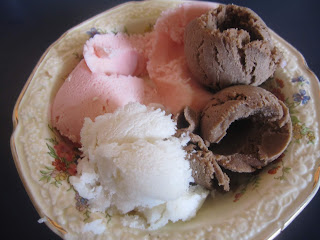Most recipes on the internet seem to be one of the following:
- based on banana;
- based on coconut milk;
- based on cashew nuts.
Cream and milk are just mixes of fat, water and protein with a smidge of emulsifier to hold them together; egg yolk is fat and water with lots of emulsifier and the kindof proteins that thicken nicely on heating. Could I make vegan substitutes by simply mixing vegan fats, water, protein and emulsifiers in similar proportions? Turns out I could and the results were great!
 | |
| vegan rose geranium ice cream, vegan chocolate ice cream and vegan vanilla gelato :-) |
- write out how many egg yolks and how many cups of cream, milk, half and half and honey are called for;
- convert those into quantities of non-dairy milk , fractionated coconut oil, cornflour and sugar using the chart below (note that you don't need to use 'silly' numbers, just round to what is convenient: I had a recipe that calculated out to 598mL milk and 224mL coconut oil - I used 2 1/2 cups milk and 3/4 cup oil (i.e. 625mL and 180mL oil) and it worked fine);
- add 1/2 tsp crushed lecithin granules,1/4 tsp liquid lecithin or 1x 1200mg lecithin capsule (squeezed out) for each 1/4 cup oil in your new recipe.
| non-dairy milk | fractionated coconut oil | cornflour | sugar | water | |
| egg yolk | 12mL | 5mL | 2/3-2 tsp* | ||
| cup of (whipping) cream | 150mL | 100mL | |||
| cup of milk | 246mL | 4mL | |||
| cup of half and half | 200mL | 50mL | |||
| cup of honey | 530g** | 1/4 cup | |||
* This will likely lead you to end up with between 1 tsp and 3 tsp cornflour per total cup of liquid in your recipe. Anywhere in that range will make a good ice cream, however, the more cornflour you use the less air will be incorporated into your mix. Some people like their ice cream more fluffy, others prefer it more gummy. You'll need to experiment to find out what you like :-)
** Note that this is far more sugar than a baking recipe would say you need to use in place of honey. That's because the sugar in an ice cream recipe depresses the melting point of the mix, making it soft when cold. Honey mostly consists of the sugars fructose and glucose - these are twice as good as the sucrose in table sugar at depressing the melting point. If you use regular sugar (i.e. sucrose) in place of honey, you need a lot more if you don't want your ice cream to end up icy!You should then basically be able to follow the dairy recipe. That likely starts off by calling you to make a custard with egg yolks and milk or cream. Instead, put the cornflour into a saucepan, make a paste with a little of the non-dairy milk then add the remaining milk and make the custard with that, adding any other ingredients as indicated by your non-vegan recipe. When that's cooked, add the fractionated coconut oil and the lecithin, turn down the heat and stir until you the oil has fully incorporated into the custard and it all looks uniform (this takes about 2 minutes). Follow the remaining instructions on your non-dairy recipe and you should end up with yummy ice cream :-)
Notes:
- I've only tried soy milk but I expect any non-dairy milk with a similar protein content would be fine.
- Fractionated coconut oil (also called RBD coconut oil - i.e. refined, bleached, deodorised - or deodorised coconut oil) is coconut oil that has been distilled to remove the distinctive coconut taste. In New Zealand, it is widely available in supermarkets. The most common brand is Blue Coconut, which is cheaper to buy from Countdown than from their own website.
- Lecithin is an emulsifier. You can get egg, soy or sunflower lecithin - to make a vegan ice cream you obviously want either soy or sunflower lecithin! Lecithin comes in three forms: granules, liquid and capsules. I haven't found any capsules that are vegan (they're all made of gelatin) - if you're making ice cream for a vegan friend that's fine as you can just squeeze the oil out and discard the capsule, but if you're actually vegan you'll want either granules or oil. I recommend granules as they come in the bulk bins at the supermarket so you can just buy what you want, whereas the liquid tends to come in 500mL bottles that are quite expensive. The granules disperse into the ice cream better if you crush them to powder first.
- If your mixture is quite dark and uniform (e.g. a chocolate ice cream mix), after it's chilled you might see small white flecks through the mix and white patches on the surface. I don't know what causes this but it's not a problem - they don't show up in the churned ice cream and don't affect the texture.
- You could use a vegan margarine in place of the fractionated coconut oil, but you need to be aware that margarine is basically 50:50 water:fat while coconut oil is straight fat. You'd need to double the weight given for coconut oil and reduce the non-dairy milk accordingly.



No comments:
Post a Comment